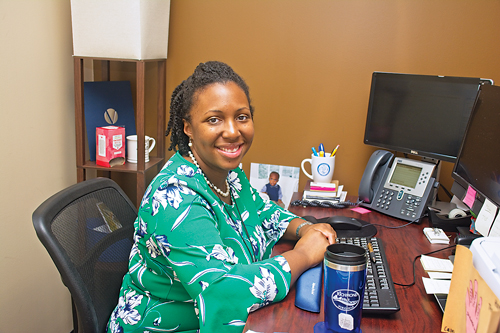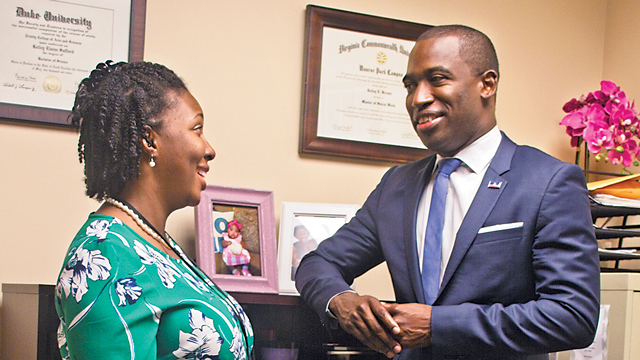 Six years ago, as they anticipated the birth of their first child, Kelley and her husband did more than just furnish the nursery – they got serious about saving. Even though Kelley had a good job in the government sector – one that provided insurance coverage for the family – the job did not include paid family leave.
Six years ago, as they anticipated the birth of their first child, Kelley and her husband did more than just furnish the nursery – they got serious about saving. Even though Kelley had a good job in the government sector – one that provided insurance coverage for the family – the job did not include paid family leave.
To prepare for the time Kelley would be at home after their child’s birth – with no regular paycheck – the couple saved for months, and Kelley’s husband took on additional part-time work to further bolster their reserves. Kelley also protected her vacation and sick leave and used short-term disability coverage, which offered 60 percent of her salary, to cover some of the bills. There was never a question of her leaving her job permanently.
“I need to work,” she says.
But with the birth of her third child on July 9, 2018, Kelley got to do something new: She stayed home for eight weeks and received her full salary from the City of Richmond, her current employer.
Thanks to a policy that went into effect July 7, 2018, Kelley and other City employees are now able to take up to eight weeks of paid family leave for the birth or adoption of a child – increased from the previous policy of four paid weeks. The City’s policy closely mirrors one enacted by Governor Ralph S. Northam earlier this year for state employees. Both policies allow for eight weeks of paid maternity leave for women who give birth, eight weeks of paid bonding leave for a non-birthing parent, and eight weeks of paid parental leave for the adoption or foster placement of a child.
Richmond Mayor Levar Stoney noted the expanded policy is useful in recruiting and retaining employees. “City of Richmond employees work very hard to keep our city running smoothly,” the mayor said. “Providing these public servants uninterrupted bonding time with a new child… is the right thing to do.”
Kelley said she heard whispers at work late in her pregnancy that a change in City policy was coming, and she was happy to take
advantage of the funded leave. “I didn’t have to worry about filling in the gaps financially,” she said. “I definitely was more relaxed this time around. It was just about being at home with my baby.”
Of course, work at the office continued. Kelley said even though she’s the primary person fulfilling certain responsibilities in her office, she and her department manager had a detailed conversation early in the pregnancy, discussing what tasks would need to be covered and how to share them among others in the department. In her absence, Kelley said her co-workers managed it amazingly.
“They were in touch to ask about the baby, but not to ask about work,” she said, adding that her paid leave was a blessing.
“This demonstrates a level of concern for employees by the City,” she said. “It shows a commitment to attract and retain people. Things like this make a difference.”
Stephanie, who also works with the City of Richmond, finished her workday on Friday, May 11, 2017, and gave birth to her first child, a daughter, the very next day. Stephanie had planned to stay on the job as long as she was able to because she wanted to use the full twelve unpaid weeks of leave to be with her baby. Multiple meetings with her supervisor and coworkers ensured that everyone knew how to cover her impending absence.
“My supervisor helped me a lot, not just preparing for my leave,” she said. “He made sure I was comfortable at all times and even sent a coworker with me [when I had to leave the office] near the end of my pregnancy, to make sure I wasn’t alone.”
Stephanie had prepared financially for the birth by saving as much as possible, but the new mom was pleasantly surprised when the City’s new policy took effect. Instead of a fully unpaid leave, based on when her baby was born (before the policy was enacted), she was able to receive four weeks of paid leave, from July 7 to August 3, her return date.
Stephanie said her leave gave her the opportunity to bond with her baby. “It gave me the time so I didn’t have the stress of work and could focus on being a mom.”
How Federal Family and Medical Leave Works
The federal Family and Medical Leave Act (FMLA), enacted in 1993, requires businesses with fifty or more employees to provide up to twelve weeks of unpaid leave, with the employees guaranteed the right to return to their job.
That legislation originated in the belief that the federal government could do more to support working parents as they strove to meet the demands of providing for their families financially as well as emotionally, particularly in times of family need arising from the birth or adoption of a child or the long-term illness of a family member, whether a child or elderly parents.
The first draft of the FMLA was written in 1984 by the National Partnership for Women and Families (NPWF), which formed a diverse coalition of advocates from across the political spectrum, including the Children’s Defense Fund, AARP, United States Catholic Conference, and trade unions, to name a few.
The NPWF notes that FMLA has been used more than 200 million times since its inception, and yet there are many workers who do not have the leave available to them because of their employer’s size, or they are simply unable to take time off from work without pay.
The U.S. Bureau of Labor Statistics, which tracks data related to the national workforce, has recorded family leave policies across multiple categories (private industry, state and local government, and geographic locations) every year since 2008. In comparing the bureau’s Employee Benefits Survey data from March 2008 to March 2017, it’s clear that more employees have paid family leave available to them now than a decade ago.
The highest rate of paid family leave availability is found in the management, professional, and related category, at 25 percent. This category includes teachers, nurses, managerial, financial, and other related job types. In 2008, paid family leave was available to 15 percent of workers in this same category. The lowest rate of paid family leave, in both 2017 and 2008, is found in the production, transportation, and material moving category (5 percent in 2008 and 7 percent in 2017). Perhaps unsurprisingly, the data also shows that workers at the lower end of the pay spectrum, across all categories, are least likely to have paid family leave available to them.

What Parent-Friendly Policy Looks Like
SunTrust is an Atlanta-based financial services company with offices in Richmond. Ashley Keogh, a senior financial manager for SunTrust, has been with the company long enough to experience its evolving family leave policy first-hand. When Keogh joined the company in 2005, paid maternal leave of six to eight weeks was covered under disability insurance, with FMLA as an option to extend leave. That was the policy in place when she had her first child in 2011, when she was out a total of twelve weeks.
For the birth of her second child in 2016, Keogh used SunTrust’s current policy, which provides maternity leave
at full pay for ten weeks, plus parental leave at full pay for six additional weeks, which can be taken in one-week increments up to the child’s first birthday. As a result, Keogh stayed home with her second child for fifteen weeks, and she used the last week of paid parental leave later in the year.
“When I went back to work after [my first child], it was hard, but I could do it,” she said. “With this new leave, it was so much easier going back just a few weeks later.”
Keogh said the additional time at home with a new child helps moms recover from the hormonal and emotional barrage that comes after childbirth. And there are practical reasons for staying home a little longer, too.
“There’s more responsibility when you’re managing a young baby,” she said. “For me, things were more in control [at home], and it felt like I was better able to return to work and manage my job, too. Plus, just getting to a point where I could get a little more sleep was key.”
Keogh said she did pay attention to SunTrust’s maternity leave policy when she was job hunting. “I didn’t think it was great, but I didn’t think it was horrible; it was common.” But now, she sees the company as being ahead of the curve with its current policy, adopted two years ago.
“It’s night and day between what the options were in 2005 and what’s available today,” she said. “I give SunTrust props for doing this early. I hope we’re touting this benefit to new employees – men and women.”
Keogh’s husband, who doesn’t have parental leave with his company, relied on saved vacation time to be home after the children were born, one week after their first child, and two after the second.
Keogh noted that SunTrust’s six weeks of paid leave for men is a good benefit, but she wonders if societal pressures sometimes prevent new fathers from taking advantage of the leave. She said one man on her team did take the leave, which she was thrilled to see. “I firmly believe marriage and parenting should be a partnership,” Keogh said.
At the University of Richmond, paid parental leave is offered for staff and faculty who have been with the university for at least a year. As a faculty member at the T.C. Williams School of Law, Jack Preis took two full-semester parental leaves, each following the birth of his two younger children.
Preis said the university’s commitment to paid leave for both parents is notable. “It was very clear to me that there would be no consequence [to my position],” Preis said. “The full semester of leave is consistent with [UR’s] deep commitment to employees and shows that there is absolutely no reason to differ between a person who births a child and the other parent.”
Preis did not take his leaves immediately after his children were born, but he did within their first years. One child was born in May, after the spring semester had concluded, so Preis took leave in the fall semester. The other child was born in January, but his mother-in-law was able to come stay with the family for an extended period in the winter, so he delayed his leave again, staying home when his daughter was eight to twelve months old.
“What tends to make that post-birth time successful is a network of help,” he said, noting that with the family’s third child in particular, his delayed leave enabled him to spend time with the baby when she was a little older and more alert. Plus, there were siblings to think about.
“You end up getting to spend more time with the other children, so they don’t feel left out,” he said. “It does make life easier.”
Preis’ wife, Alsúin, said it was helpful to have the leave available for their two younger children, born eighteen months apart. “He got to know the rhythms of his children in a completely unforced way,” she said. “It was so good for him to be hands-on at that age, and it made things so much easier.”
Alsúin Preis, who is originally from Dublin, Ireland, notes that family leave in Europe is much more generous than what’s typically found in the United States. “Family leave is a way to say there are certain things we care about as a society,” she said.
Who Benefits from Family Leave?
SunTrust’s family leave policy is designed to support the company’s goal of “lighting the way to financial well-being,” says Katherine Brune, senior vice president for well-being and benefits.
“[Paid family leave] is a great opportunity for us to put our money where our mouth is and help with the financial stress of having a new child,” Brune said. “Financial confidence is about being there for the moments that matter, and we want to focus on the moments that matter.”
Brune noted that with so many families living paycheck to paycheck, paid family leave is essential to preserve a family’s financial well-being. “The good thing about this type of leave is that you do know it’s coming,” she said. “The employee can step back and prioritize the work, decide what to hold and decide what to ask a teammate to pitch in on, if only taking a week or two at a time.”
SunTrust’s leave policy is available to every full-time employee after a year of work with the company. The policy also covers up to six paid weeks of leave for fathers, domestic partners, and adoptive parents, though Brune noted that dads aren’t always taking the full
6-week benefit.
“We don’t have 100 percent uptake from new dads,” she said. “We have a respectable number who take a couple of weeks, and most take it in increments; there’s safety in knowing it’s there if you need it. The message alone means a lot to our teammates. It’s about that bonding time and those moments that matter to Dad, too.”
Brune mentioned one teammate’s recent visit to the office as a great example of how leave is supposed to work. The mom shared pictures of a family camping trip that had occurred during the final days of her family leave. “She’s out there being able to take advantage of that moment and bonding with her newborn,” Brune said. “It’s been really great seeing [this program] come to life.”
New mom Kelley said the City of Richmond’s willingness to provide paid leave really helped her and her family. “It meant something to me that the City is doing this,” she said. “I’m really thankful.”




